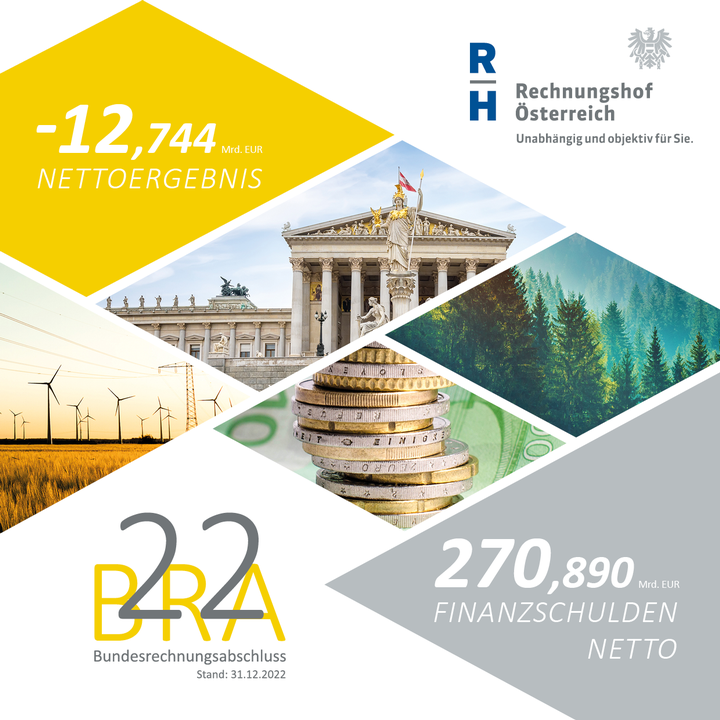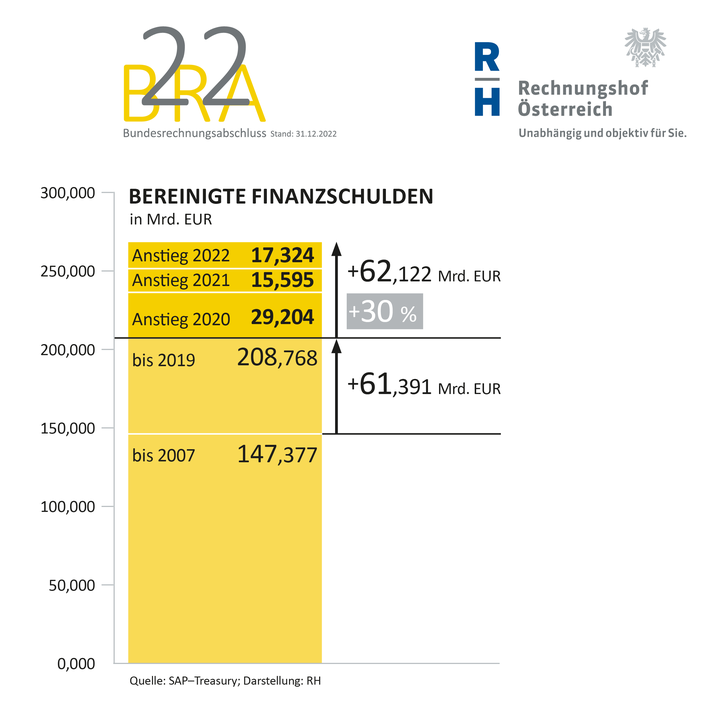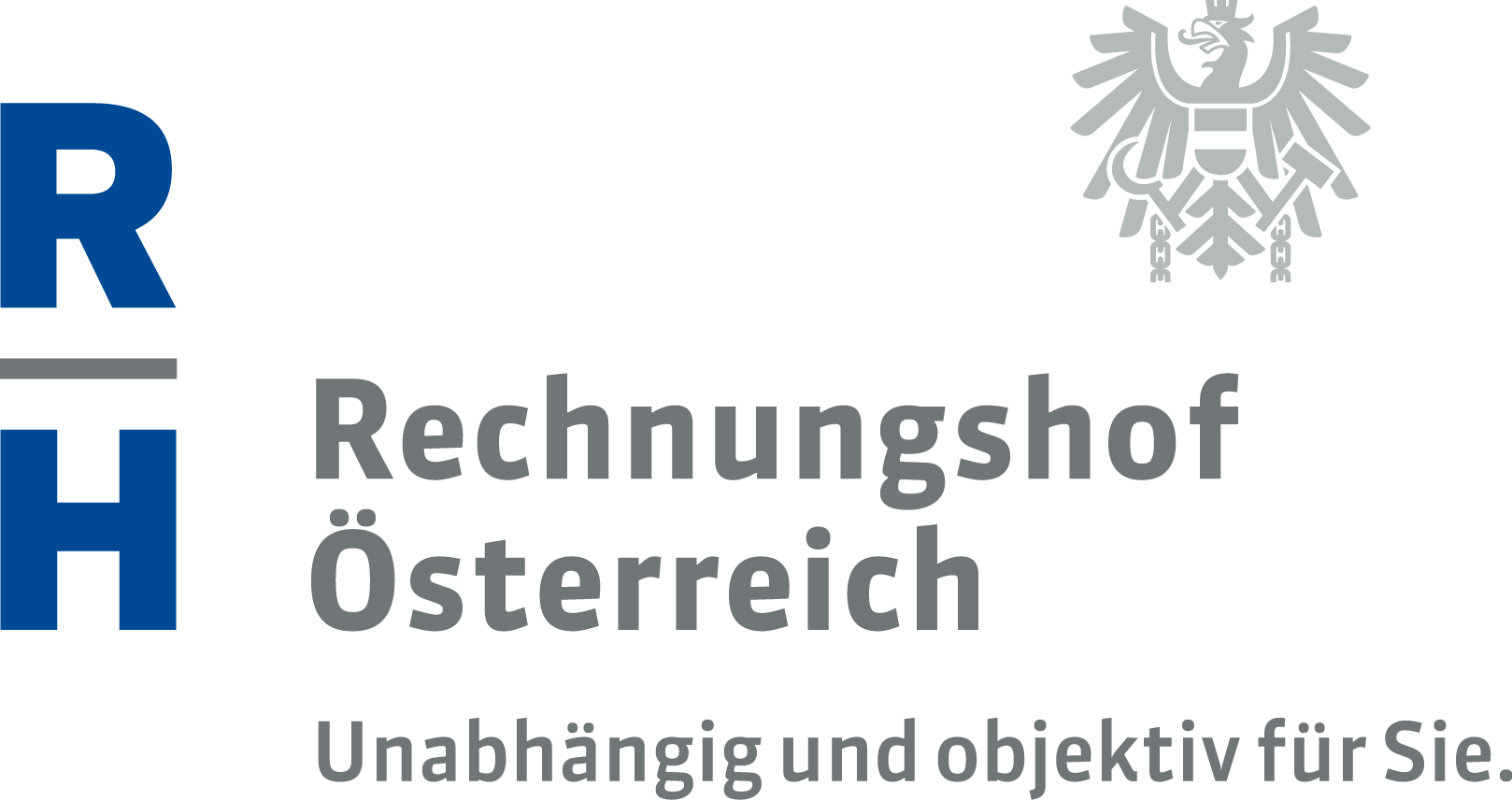Report on the Federal Financial Statements 2022: sharp increase in financial debts

In 2022, the federal budget saw a high negative net result amounting to minus EUR 12.744 billion for the third time in a row. The cash flow statement showed a deficit of EUR 20.762 billion. Financial debts increased to EUR 270.890 billion. The Federation’s financial debts increased by around 30 per cent in just three years. This is revealed in the Report on the Federal Financial Statements 2022, which the ACA published today. The 2022 results have to be seen against the backdrop of a strong economic growth of 5.0 per cent in real terms. However, inflation also increased to 8.6 per cent, the highest level since 1974.
In order to overcome the COVID-19 pandemic and to mitigate the effects of inflation, extensive aid packages were passed in 2022, which led to a considerable increase in financial debts. According to forecasts, the share of the state’s interest expenditure for financing its debts will steadily increase as measured by economic output.
From 2020 to 2022, the Federation disbursed EUR 42.693 billion exclusively for measures to overcome the COVID-19 pandemic.
The Federation’s financial debts increased to EUR 270.890 billion
As at 31 December 2022, the Federation’s adjusted financial debts totalled EUR 270.890 billion or 60.5 per cent of the gross domestic product (GDP). Thus, they increased by EUR 17.324 billion or 6.8 per cent compared to 2021. The significant increase in financial debts resulted from the aid measures to overcome the COVID-19 pandemic as well as from the relief measures to compensate for inflation. From 2020 to 2022, costs in the amount of EUR 32.837 billion were incurred for COVID-19 crisis management. This amount included the COFAG measures, which accounted for EUR 15.286 billion. The COVID-19 short-time work allowance added another EUR 9.856 billion to the expenditure.

The Federation’s financial debts increased by a total of EUR 62.122 billion within just three years – from 2019 to 2022. This increase was higher than during the twelve years before – from 2007 to 2019 when the financial crisis had to be tackled.
As from 2020, because of the Federation’s high deficits due to the crisis, both the volume of financial debts taken on each year and the share used to finance the deficit were significantly higher than in previous years. On average, 35 per cent of borrowing was required to meet the deficits from 2020 to 2022. In the period from 2012 to 2019, this share amounted to an average of 12.7 per cent. The remaining portion was used to repay maturing financial debts.
National development of public debt
According to forecasts, public debt as measured by economic output will decrease in the years to come. Since the nominal GDP increased sharply due to inflation, the debt-to-GDP ratio decreased to 78.4 per cent but increased by EUR 16.424 billion in absolute terms to EUR 350.770 billion in 2022. For 2026, the Federal Ministry of Finance forecasts a ratio of 71.4 per cent, which means that it remains a long way off the Maastricht objective of 60 per cent of GDP. In the long run, the debt-to-GDP ratio will increase due to rising expenditure for pensions, healthcare, old-age care as well as for climate action required to reduce greenhouse gas emissions.
Interest expenditure increases steadily
Due to the altered interest environment, expenditure for debt servicing increases, which results in higher interest obligations. Accordingly, future budgets are at a high risk, as the historically low interest rate level of the end of 2021 significantly rose in the course of 2022. In addition, with inflation remaining high, it remains to be seen when the European Central Bank will stop increasing its policy rate. The share the state has to spend on interest payments increases considerably. According to a forecast prepared by the Federal Ministry of Finance, interest expenditure will increase from 0.9 per cent of GDP in 2022 to 1.6 per cent of GDP in 2026.
In this context, the ACA points to its medium-term audit priority: “Next Generation Austria. Are we passing on something besides debt to the next generation? On the future role of the state for the next generation.” In the ACA’s opinion, structural reforms should be advanced and room for manoeuvre should be created in terms of fiscal policy in order to achieve a sustainable budget trajectory. Furthermore, it would be crucial to reach a nationwide pro-reform consensus in financial equalization negotiations by setting objectives across all levels of government, in particular in the areas of old-age care and healthcare.
Net result remains highly negative at minus EUR 12.744 billion
In 2022, the federal budget saw a high negative net result amounting to minus EUR 12.744 billion for the third time in a row. Even though the net result improved by EUR 6.901 billion compared to the previous year, it was still far below pre-crisis levels. With EUR 819.08 million, the year 2019 still saw a surplus.
Revenue increased by EUR 7.948 billion compared to the previous year, which resulted from increases in tax revenue, in particular due to high inflation and the favourable economic development.
Expenditure was by EUR 1.047 billion higher than in the previous year. The climate bonus, compensations paid to transport associations for the climate ticket Austria, cost reimbursements for conducting COVID-19 tests, compensations paid to energy supply companies for the energy cost credit as well as expenditure for measures stipulated by the Austrian Recovery and Resilience Plan contributed to the increase.
In 2022, the Federation’s assets accounted for EUR 121.854 billion and thus increased by EUR 4.193 billion compared to the previous year. The increase resulted from, among other things, the setting up of a national strategic gas reserve.
Accuracy of anti-inflation measures should be improved
In 2022, the relief measures to mitigate the effects of inflation strongly influenced the federal budget. A total of EUR 4.534 billion was disbursed for these measures. The increase of the climate bonus together with the anti-inflation bonus in the amount of EUR 2.734 billion took up the largest share of financial support, i.e. 60.5 per cent. The Federal Ministry of Finance estimates that the relief measures to fight inflation will cost EUR 32.330 billion for the years 2022 to 2026. Due to this heavy budgetary burden, the ACA points out that the broad inflation relief measures as well as temporary financial support should be reviewed as to their sustainability. In the interest of a sustainable budgetary policy, it should be ensured that measures are demand-oriented, targeted and accurate.
Wind-down strategy for foreign currency portfolio should be established
The ACA could not validate the plausibility of the provision for the foreign currency risk pertaining to a portfolio held in Swiss Francs. The Federal Ministry of Finance did not provide the ACA with documents that rendered the assumptions underlying the recognition of the provision comprehensible, such as a wind-down strategy for the foreign currency portfolio. At the time of the audit, the Federation’s foreign exchange rate risk accounted for EUR 5.852 billion in the event of a withdrawal from the foreign currency. The ACA recommends establishing a detailed wind-down strategy for the foreign currency portfolio.
In an interactive graph, available at rechnungshof.gv.at/bra2022 (in German), the ACA provides an overview on the Federation’s assets and debts.
Financial Statements 2022 (CSV Format)
Please note that the download of the documents below may take some time due to the large volume of data.
- pdf Datei:
- 697.5 KB
Overview of the Federal Budget 2022 (in German)
- pdf Datei:
- 4,644.1 KB
Text Section Volume 2: Subdivisions (in German)
- pdf Datei:
- 3,852.3 KB
Text Section Volume 3: Financial Debts (in German)
- pdf Datei:
- 2,795.5 KB
Text Section Volume 4 Regularity Audit Pursuant to Section 9 of the Court of Audit Act (in German)
- pdf Datei:
- 3,197.6 KB
Text Section Volume 5: Preliminary Audit of Federal Guarantees (in German)
- pdf Datei:
- 7,274.4 KB
Set of Figures: Federation (in German)
- pdf Datei:
- 26,343.8 KB
Detailed Set of Figures: Federation (in German)
- pdf Datei:
- 4,775.0 KB
Financial Statements of Organizational Units (in German)
Financial Statements in CSV Format (in German)
Statement of Financial Position – Long Version
Cash Flow Statement – Long Version
Operating Statement – Long Version
Statement of Comparison of Budgeted and Actual Amounts Operating Statement – Expenditure
Statement of Comparison of Budgeted and Actual Amounts Operating Statement – Revenue
Statement of Comparison of Budgeted and Actual Amounts Cash Flow Statement – Outflows
Statement of Comparison of Budgeted and Actual Amounts Cash Flow Statement – Inflows
Statement of Comparison of Budgeted and Actual Amounts Cash Flow from Financing Activities – Inflows
Supplementary Budget Documents (in German)
Budget Chapter 01 Office of the Federal President
Budget Chapter 02 Federal Legislation
Budget Chapter 03 Constitutional Court
Budget Chapter 04 Supreme Administrative Court
Budget Chapter 05 Austrian Ombudsman Board
Budget Chapter 06 Austrian Court of Audit
Budget Chapter 10 Federal Chancellery
Budget Chapter 11 Internal Affairs
Budget Chapter 12 Foreign Affairs
Budget Chapter 14 Military Affairs
Budget Chapter 15 Financial Administration
Budget Chapter 16 Public Expenditure
Budget Chapter 17 Civil Service and Sport
Budget Chapter 20 Labour and Employment
Budget Chapter 21 Social Affairs and Consumer Protection
Budget Chapter 22 Pension Insurance
Budget Chapter 23 Pensions – Civil Servants
Budget Chapter 25 Families and Youth
Budget Chapter 31 Science and Research
Budget Chapter 32 Arts and Culture
Budget Chapter 33 Economy (Research)
Budget Chapter 34 Innovation and Technology (Research)
Budget Chapter 42 Agriculture, Forestry, Regions and Water Management
Budget Chapter 43 Climate Action, Environment and Energy
Budget Chapter 44 Financial Equalization
Budget Chapter 45 Federal Assets
Budget Chapter 46 Financial Market Stability
Budget Chapter 58 Financing, Currency Swap Agreements


